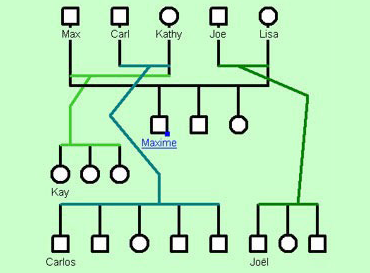 A genogram, sometimes called a family map, is a pictorial display of a patient’s family relationships and medical history. It goes beyond a traditional family tree by allowing the user to visualize hereditary patterns and psychological factors that punctuate relationships. It can be used to identify repetitive patterns of behavior and to recognize hereditary tendencies.
A genogram, sometimes called a family map, is a pictorial display of a patient’s family relationships and medical history. It goes beyond a traditional family tree by allowing the user to visualize hereditary patterns and psychological factors that punctuate relationships. It can be used to identify repetitive patterns of behavior and to recognize hereditary tendencies.
Genograms were first developed and popularized in therapuetic settings by Monica McGoldrick and Randy Gerson through their book titled Genograms: Assessment and Intervention in 1985.
Genograms are now used by various groups of people in a variety of fields such as psychiatry, psychology, genealogy, and medicine. Some therapists in individual, couples and family therapy use genograms for personal records and to explain family dynamics to their client.
Genogram Symbols
A genogram is created with different symbols representing the gender, with various lines to illustrate family relationships. Some genogram users also put circles around members who live in the same living spaces. Genograms can be prepared by using a complex word processor, or a computer drawing program. There are also computer programs that are custom designed for genograms.
Genogram symbols will usually have the date of birth (and date of death if applicable) above, and the name of the individual underneath. The inside of the symbol will hold the person’s current age or various codes for genetic diseases or user-defined properties, such as abortions and still-births.
Genogram Content
A genogram can contain a wealth of information on the families represented. It shows not only the names of people who belong to your family lineage, but how these relatives relate to each other. For example, a genogram will not only tell you that your uncle John and his wife Jill have two children, but that their eldest child is in college, that their youngest child is always in conflict with her sister, that John suffers from depression, and Jill has a history of breast cancer in her family.
Relationships
One of the advantages of a genogram is the ability to use color-coded lines to define different types of relationships such as family relationships, emotional relationships and social relationships. Within family relationships, you can illustrate if a couple is married, divorced, common-law, engaged, etc.
Genograms usually also include emotional relationships. These provide an in-depth analysis of how individuals relate to one another.
Another component of genograms is social relationships. These allow users to link individuals who are not related to one another, but who have a connection in society-at-large, such as neighbor, co-worker, boss-employee, pastor-church member, teacher-student, etc.
The Purpose of the Genogram
In therapy, genograms are used to gather objective and consistent information from the clients and their family, helping them to view the client’s issues in the larger context of their marital relationship, family relationships and culture of origin and underlining key issues to discuss in client counseling. Genograms portray emotional relationships, which allow psychologists to see and evaluate possible conflicts within the family.
A genograms is a useful tool to for helping people to understand the key people and relationships in a their life. It can also help someone to see patterns within those relationships and generational patterns which are affecting them. Because of the pictorial nature of a genograms it clearly shows issues and concerns that might not be spoken about usually in a non-threatening way.
Genograms also puts a framework together that can explain a person’s circumstances. For example, many people who are in a verbally abusive relationship struggle to speak about it, however showing them how to draw a genograms can lead them to an open dialogue. It can also help them to find a strength based way of working through the issues.
Dr. Randi Fredricks, Ph.D.
Author Bio
Dr. Randi Fredricks is a leading expert in the field of mental health counseling and psychotherapy, with over three decades of experience in both research and practice. She holds a PhD from The Institute of Transpersonal Psychology and has published ground-breaking research on communication, mental health, and complementary and alternative medicine. Dr. Fredricks is a best-selling author of books on the treatment of mental health conditions with complementary and alternative medicine. Her work has been featured in leading academic journals and is recognized worldwide. She currently is actively involved in developing innovative solutions for treating mental health. To learn more about Dr. Fredricks’ work, visit her website: https://drrandifredricks.com

References
Bowen, M. (1978). Family therapy in Clinical practice. New York: Jason Bronson.
Connolly, C. M. (2005). Discovering “family” creatively: The self-created genogram. Journal of Creativity in Mental Health, 1(1), 81-105.
Glasser, W. (1998). Choice theory: A new psychology of personal freedom. New York: Harper Perennial.
Marlin, E. (1989). Genograms. Chicago: Contemporary Books.
McGoldrick, M., & Gerson, R. (1985). Genograms in family assessment. New York: Norton.
